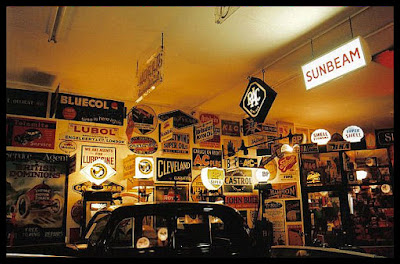Situated in the quiet and pretty village of Colyford, this gem of a museum has attracted thousands of visitors since it opened some twenty years ago. Sadly, it closed its doors for the last time at the end of September 2011 and the 40 years worth of the motoring memorabilia collection was sold off.
The architect, a Mr Kett, designed the station based on the wooden one at Countess Wear at the time, changing the building materials to block and brick and adding the Mock Tudor dormer. Built by local builders, it was completed in 1928, and offered Shell, BP, National Benzole and Redline petrol from four Hammond Visible hand operated pumps.
Some of its history includes visits from Aircraftman Thomas Edward Shaw, better known as Lawrence of Arabia. A frequent customer to the station on journeys between his home near Bovington Camp in Dorset and his Royal Airforce posting in Plymouth, he bought petrol for his Brough Superior Motorcycle...and it was on one of these journeys that he had the road accident near his home which led to his death on 18th may 1935.
It was also during the 1930s that Devon County Council decided that all petrol stations should be tidied up, and that Colyford station was the best example of how they should look.
During WW2 all petrol had to be 'pooled' and rationed, enabling the essential reserved occupations of ambulance drivers, doctors, fire service personnel, police and farmers etc, to receive a larger allocation of coupons than the general public. When rationing ended during the 1950s there was greater mobility, and petrol sales increased. However, it wasn't until the 1960s that stations were persuaded by petrol companies to sell just one brand, rather than four or five different ones, and Colyford became the sole supplier of Shell.
Sid's Motor Works (seen above and below) is a display representing the shop, stores and office of a 1930s garage, full of original tins and boxes with the company names and logos on them.
My photos were a bit hit and miss on this quick visit, so I do apologise for a few out of focus ones.
The present owner, Robin Barnard, bought the site in January 1982 and continued trading as a petrol station until September 2001. At that time it became obvious that cheap petrol from supermarket chains was outpricing the small, individual stations, and it was then that Mr Barnard decided to realise his dream of a museum. An extension was built on the side of the station, which was then used to house the massive 40 year old collection of cars, posters, globes, pumps and other memorabillia.
Although I'd known about the museum for many years, it was one of those places that I meant to visit but didn't get around to until I read an article in the local newspaper that it was about to close. I only had half an hour to whizz around with my camera at the time, and fully intended to return before it closed for good. Unfortunately there was only a week to go and I wasn't able to make it after all. However, I'm very glad I did get to see it, albeit briefly, as it was such an amazing collection and so beautifully displayed.
The petrol pumps outside remained when the rest of the collection was sold. A delightful little fact is that the Levi's advert 'Funeral' was partially filmed outside the station. Don't know why they bothered though, as they made it look completely different. Maybe it was just used for inspiration rather than actually changed. Great ad mind, and fab music.
https://www.youtube.com/watch?v=CD33wOo-TgA
And finally, one of the windows with its delightful panes of green and yellow glass at the top. Oil cans hanging up behind one of these windows was one of the interior photos that I missed...one of those enduring images that I remember from my visit.
























































